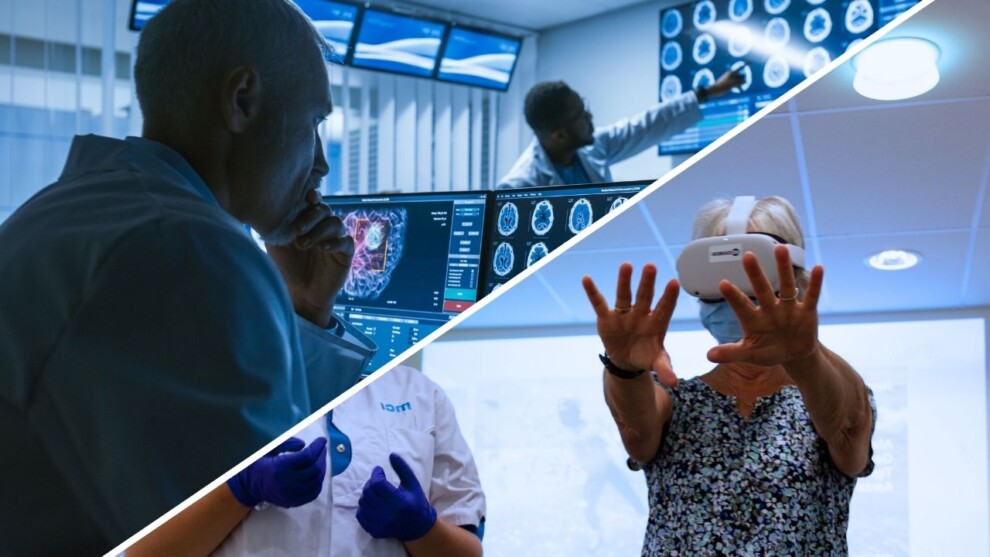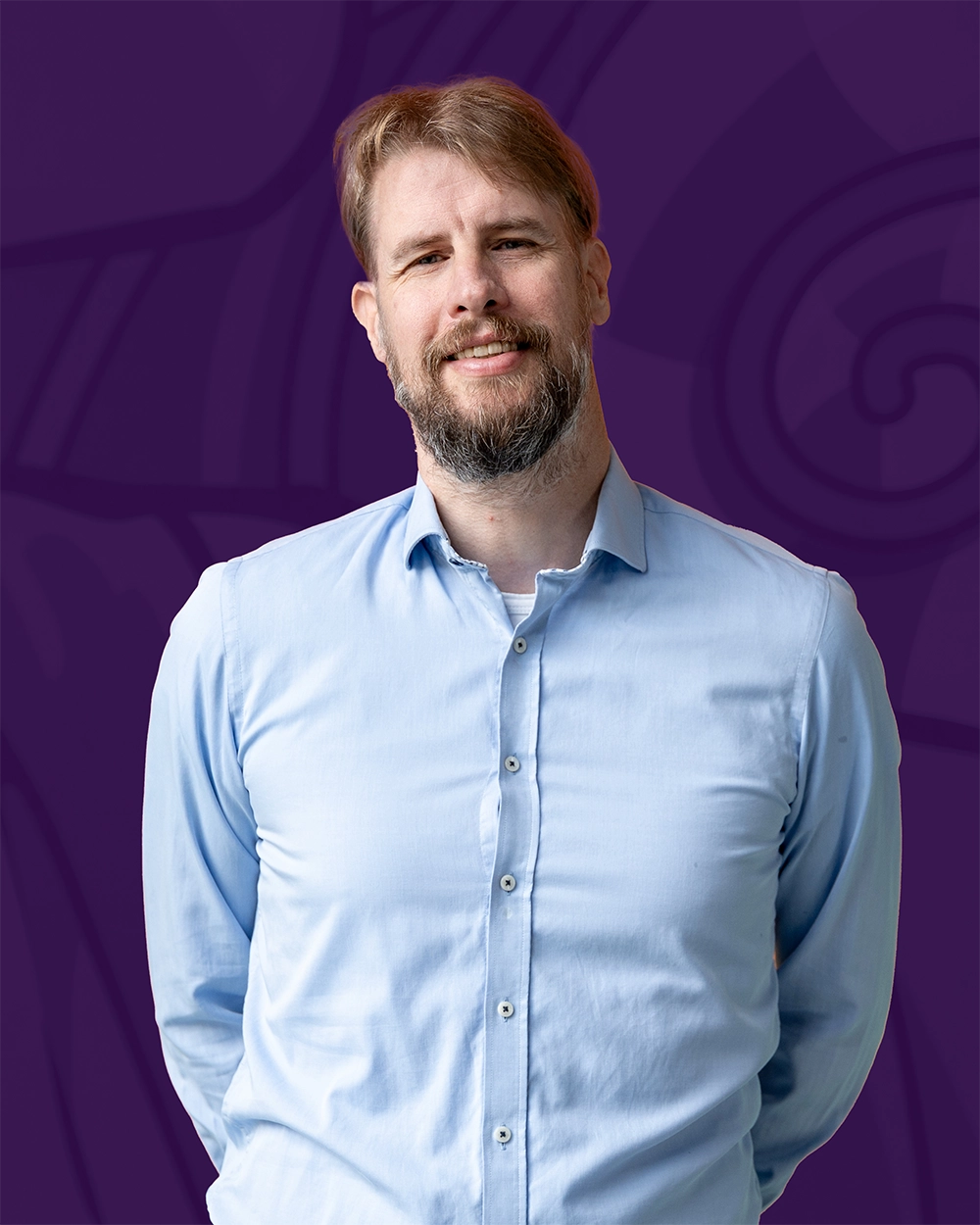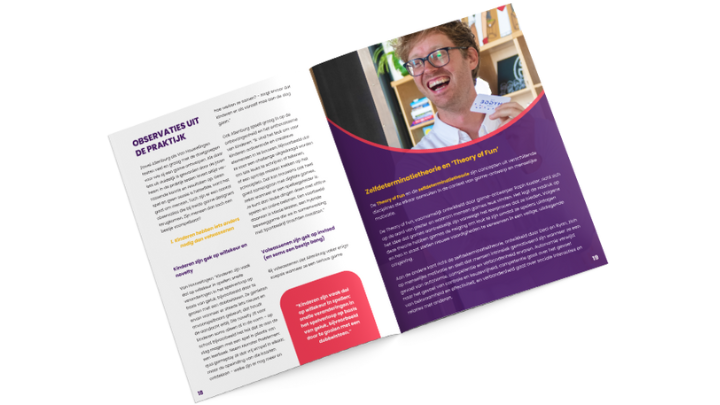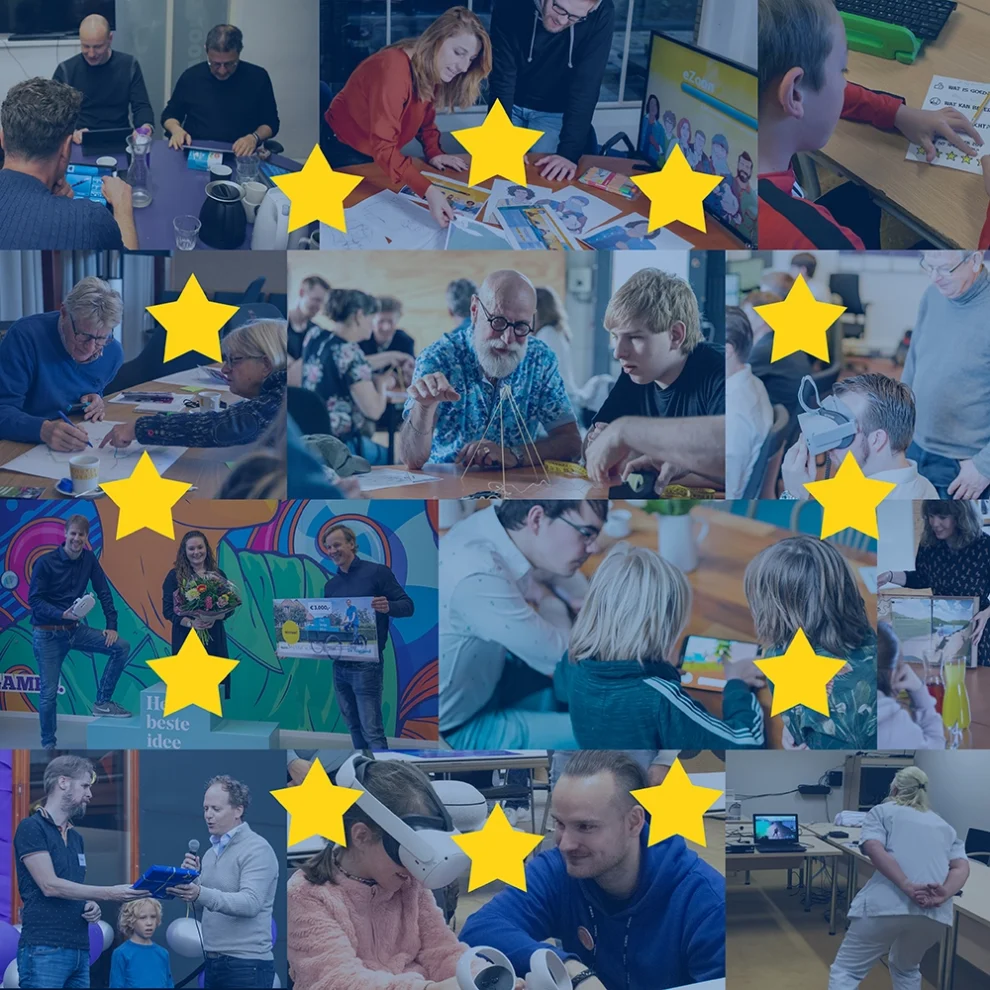1. Serious Gaming as a Research Method – how does that work, exactly?
Developing a serious game is an iterative and co-creative process. You don’t just start building a game; you first work closely with the target audience to investigate what kind of game is needed to effectively solve your challenge. Ideally, you involve the necessary domain experts and end-users in all steps of the process: from problem definition to concept development, and from prototype to finished game. This combination of gaming and research makes the process incredibly enjoyable but also challenging. In a co-creative process, you don’t know from the start what type of product you will end up with; you go in with an open mind to achieve as much impact as possible. This sometimes requires a different, more flexible approach than some funders and knowledge institutions are used to. But it is possible and worthwhile.
One of the main advantages of research with a serious gaming methodology is that you can test and measure things with the target audience at all stages of the development process. Not just with the final product, but certainly at the beginning: from the concept phase to the first (simple) concept or prototype. How does the target audience experience the problem you are trying to solve? And what do they think of the proposed solution? We regularly see that sessions with the end-user yield valuable knowledge for researchers. The framework of ‘developing a game together’ often removes the sting from the subject for target group participants. They discuss their desires for the solution in a concrete, creative way that often provides you, as a researcher, with more (and more nuanced) data about the problem at hand.
Once there is a prototype, the game as a final product obviously also provides research opportunities, especially when it comes to digital games. An example: with a sensor game—perhaps to make rehabilitation exercises more enjoyable—researchers and doctors can precisely see what movement is being made and how the body responds to the game. Are the exercises being done correctly and sufficiently? In education, implementing an educational game often provides more insight into students’ learning processes. Does the game have a positive effect on behavior and thoughts in young people? These kinds of questions can be incorporated into the game’s design, providing value to the research field.
Want to Learn More About Research, Serious Gaming, and Healthcare?
In our webinar with Lise Beumeler on research, serious gaming, and healthcare, it was highlighted that innovative technologies like VR can significantly improve the effectiveness of rehabilitation therapy, especially when implemented correctly. It is important to thoroughly test whether the game works, and this is where research plays a crucial role. There is no serious game without scientific backing. This webinar specifically focuses on gaming in healthcare, but the lessons and examples are relevant and inspiring for researchers in all domains.
2. How do you incorporate serious gaming into a research proposal?
Suppose you want to write a research proposal in which serious gaming and design-oriented research play a significant role. How do you go about that effectively? The development of a serious game is an iterative and co-creative process, where ideally, you do not yet know exactly what the final product will be. This can sometimes be challenging to align with the requirements of funding bodies. They – understandably – want to know exactly what the outcomes of each project phase will be. Here are some tips:
- Engage your stakeholders in the planning phase. Before writing the proposal, establish contact with as many stakeholders as possible. Think of intended end-users, experts by experience, and professionals who would use the final product in their work practice. Present the project idea to them and learn from their input. Try to map out whether there is a need for solutions to the identified problem and whether the problem is as you thought. This forms the basis of your needs analysis, an important foundation for your proposal. Simply put: does the target audience also think this project should come about in the way you describe in the proposal? If you can demonstrate this, you’ve often won half the battle.
- Take the user context into account – you can’t be early enough with this. During the ideation phase, ask end-users and professionals about their ideas on using the innovation in their daily lives or work practices. For example, would they want to play the game during breaks? Alone or in teams? Are there fixed work practices where the game could be perfectly embedded? This may seem strange since you don’t yet know what the game will look like. However, by taking the time to explore together what the use context and exact goal of the game should be, you lay the groundwork for a promising product. This allows you to consider implementation wishes already in the design phase, which contributes to the success of your proposal.
- Focus on clearly explaining the ‘why’ of your process, instead of the exact form of your results. In an iterative process, you want to leave room for changes in direction based on tests, conversations, and other contact moments with the target audience. At the same time, it is important to be as specific as possible about what you will do during the research process. It can be difficult to describe what a design process with the target audience looks like if you have no experience with it. Let us help you with this! We always work in a structured way, with different outcomes but the same steps, which are well-supported by literature and case studies.
- Need inspiration? Don’t hesitate to contact Maarten or Johan, who can guide you. And if we discover common goals, our experienced proposal writer Nicole would be happy to help you write the work packages, especially the design-oriented ones. A consultation is always free, and there are no obligations. (Except maybe for the many tangents Maarten and Johan might take, out of sheer enthusiasm for the field).
Moreover, consider this: what if the end goal of your research is not an end product—like a game—but rather gaining more knowledge through a design-oriented research methodology? In other words, can the process of game development also function as a research tool? After ten years of co-creation, we can only answer this with a resounding “yes.” Co-designing is an excellent way to explore, in a playful manner, what does and doesn’t work for a specific target audience, and why. It is, in fact, a form of participatory action research. And we are increasingly understanding how to effectively employ gaming as a method. Read more about design-oriented research in our article on the collaboration with the Master Serious Gaming program at NHL Stenden University of Applied Sciences.
3. Co-creation, isn’t that needlessly complicated?
Co-creation and serious gaming are, of course, entirely different forms of research compared to traditional approaches. In co-creation, stakeholders and target audiences are closely involved. This may seem complicated, but it is actually beneficial for the development process. Involving parties in the development process ensures that the final product precisely meets the wishes and needs of both stakeholders and the target audience. Therefore, it is important to communicate clearly with all involved from the beginning, so that potential obstacles or concerns can be identified and avoided in time.
Co-creation is more than just sitting at a table with a bunch of ideas. By investing a lot of time and energy in collaboration during the initial phase, you save time in the long run and achieve a more effective solution. It has often been shown that co-creation not only leads to better results, but also ensures that the final product is more successfully and sustainably implemented in practice. This is, of course, the ultimate goal of innovation. A solution is only a solution if it is actually used.
4. Why are patients and other target groups involved in research through gaming?
Regardless of the target group, it’s important to incorporate the wishes and needs of the end-user in the development process of serious gaming, as this greatly increases the chances of the research results actually finding their way to end users and society. And during the co-creation process, it is essential that all voices are heard. Consider who will be impacted by your innovation: patients, healthcare professionals, the IT department, family members, and close ones? Think broadly! Then, ensure that all these voices are heard. This requires skill, as not everyone can or wants to dominate discussions in brainstorming sessions or focus groups. Ensure that the process facilitator uses a well-supported method to uncover all desires and needs, even from participants who may find it difficult to share or articulate their thoughts. Often, it’s a matter of asking questions without judgment and genuinely wanting to understand. For example, we often use the design thinking method as described by Robert R. Curedale, both in the concept phase and during the testing of creative concepts and prototypes. Please don’t hesitate to contact us to hear more about our experiences, as they will help you get a grasp on the potential of this method. Truly involving target groups always adds more value, both to your research and to the impact of the results.
An example from our portfolio: together with researcher Lise Beumeler, 8D Games developed a virtual reality game for rehabilitating ICU patients. Why virtual reality? Certainly not because we had thought so beforehand. On the contrary, we initially believed that a VR headset would be too daunting for this target group. However, during the very first test—before anything was decided or developed—it turned out that this form was by far the most appealing to the target participants. We simply let both patients and caregivers try out different types of hardware and serious games; and the results were very clear. Neither our game designers, the researcher, nor the healthcare professionals could have predicted that in advance.
In this VR-revalidation prototype, patients enter a cozy virtual living room using the VR headset. In this game environment, they can solve a jigsaw puzzle from their chair, where the movements they make mirror the prescribed rehabilitation exercises. It is important to design a game that is accessible and safe for patients. Therefore, in all testing phases, we carefully considered both the experience and safety of the patient. Patients, both young and old, were enthusiastic about virtual reality because it provided distraction from pain. Thus, they could momentarily step away from the healthcare environment and train their motor skills in a playful and safe manner. The effectiveness of the VR experience is currently being further researched and tested by Movement Sciences students from the University of Groningen.
Read more on implementation of healthcare innovations
Want to learn more about best practices for implementing healthcare innovations? In our white paper “Why Serious Games for Healthcare Do/Do Not Reach the End-User,” we delve deeper into this topic. The importance of co-creation and iterative work is also extensively covered, with plenty of practical examples.
5. What are the main challenges when using serious gaming strategies in your research?
The biggest challenge we see with serious gaming for research and (healthcare) innovation is balancing interests and creating sufficient support among all the different stakeholders. On one hand, you are innovating, with all the uncertainty that entails. On the other hand, you have to consider many practical aspects and expectations. Developing an innovative solution that is relevant and practically implementable is, therefore, a complex process. It is crucial to have the support of involved institutions – but this can also hinder the momentum of an innovative project. After all, there are stakeholders with different desires who want to see results.
To balance all these desires and variables in the early stages, it is useful to invest time in design thinking and co-creation. By establishing good cooperation among stakeholders early on, you ensure that the development process goes smoothly. This creates mutual trust in the process. The great advantage of co-creative and iterative work is also its flexibility: you can quickly create and test prototypes. If it doesn’t work as expected for the target audience, you adjust your idea. This way, innovative ideas are translated into substantiated, practical solutions. And we would say: it is the only way to develop supported solutions.
The ‘serious gaming mindset’ is of great value for healthcare and research, but also beyond these domains. Consider other areas as well: studying human behavior, improving communication and team building, battling physical inactivity in children, increasing knowledge of nature, and having difficult conversations at work or with family. These are all examples of issues we have worked on through combining serious gaming with research and innovation. However, if we want the research results and solutions to make an impact in the real world, we must collaborate as effectively as possible across domains. A sustainable connection between researchers, designers, end-users, and policymakers is essential for this – and we believe a design-driven and collaborative approach to innovation and research is the key to establishing such connections.
Do you want to learn more about the innovation process from A to Z, so you can address crucial questions for your research and innovation proposal early on? Get in touch. We’d be happy to help you. If your project aligns with our ambitions and expertise, we are very open to explore how we can collaborate to create a successful proposal.
Questions? Need a sparring partner?
Maarten likes to think along!





